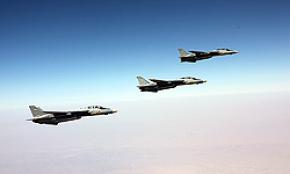ID :
179265
Mon, 05/02/2011 - 09:23
Auther :
Shortlink :
https://www.oananews.org//node/179265
The shortlink copeid
Iranian Air Force Equips F-14 Fighter Jets with Hi-Tech Radars

TEHRAN , May 2 (FNA)- The Islamic Republic of Iran Air Force has equipped all its F-14 fighter jets with highly advanced radars, Lieutenant Commander of the Iranian Army Rear Admiral Farhad Amiri announced on Sunday.
"The radar system of these fighters are highly complicated because it consists of a set of separated parts which should be linked to each other when they are mounted on the fighter jet, and this is a very complex scientific and technological process," Amiri told FNA.
"Our radars used to be mainly American and British in the past and these were the Americans and the British who determined the place for mounting our radar systems and they were, thus, fully informed of their blind spots," he said.
"But today that we produce all our radar systems domestically, we ourselves specify the place where these systems should be mounted and installed," the senior Army official said, and added, "And we cover the blind spots with other systems."
Iranian officials have announced that the country has now reached self-sufficiency in producing radar systems in different frequencies and for various ranges.
Also, Commander of Khatam ol-Anbia Air Defense Base Brigadier General Ahmad Miqani announced in November that the country's experts are boosting the range of home-made air defense radar systems to 3000km.
"Iran is working on a radar system that can cover areas within a range of 3,000 km," Miqani said, adding that the system will enable the country to identify all flying objects around the country.
A senior Iranian Air Defense commander also said in October that Iran's radar systems can detect all flying objects in the entire region, even in the Persian Gulf littoral states.
"In addition to the Southern borders and waters, all Persian Gulf littoral states are under the cover of the radars of the Khatam ol-Anbia Air Defense Base," Commander of the Air Defense Unit of Southeastern Iran General Habibollah Alizadeh told FNA at the time.
Referring to the production of radar equipment and instruments inside the country, he said that Iran has gained self-sufficiency in producing radar systems and it is no more dependant on any foreign country in this ground.
"The radar system of these fighters are highly complicated because it consists of a set of separated parts which should be linked to each other when they are mounted on the fighter jet, and this is a very complex scientific and technological process," Amiri told FNA.
"Our radars used to be mainly American and British in the past and these were the Americans and the British who determined the place for mounting our radar systems and they were, thus, fully informed of their blind spots," he said.
"But today that we produce all our radar systems domestically, we ourselves specify the place where these systems should be mounted and installed," the senior Army official said, and added, "And we cover the blind spots with other systems."
Iranian officials have announced that the country has now reached self-sufficiency in producing radar systems in different frequencies and for various ranges.
Also, Commander of Khatam ol-Anbia Air Defense Base Brigadier General Ahmad Miqani announced in November that the country's experts are boosting the range of home-made air defense radar systems to 3000km.
"Iran is working on a radar system that can cover areas within a range of 3,000 km," Miqani said, adding that the system will enable the country to identify all flying objects around the country.
A senior Iranian Air Defense commander also said in October that Iran's radar systems can detect all flying objects in the entire region, even in the Persian Gulf littoral states.
"In addition to the Southern borders and waters, all Persian Gulf littoral states are under the cover of the radars of the Khatam ol-Anbia Air Defense Base," Commander of the Air Defense Unit of Southeastern Iran General Habibollah Alizadeh told FNA at the time.
Referring to the production of radar equipment and instruments inside the country, he said that Iran has gained self-sufficiency in producing radar systems and it is no more dependant on any foreign country in this ground.





